 Today, the very first classes came to participate in International Dot Day lessons. Ms. Olin’s 5th grade class read The Dot by Peter Reynolds. We talked about what it means to make your mark on the world. I loved hearing their ideas because they really had a sense of how they could make a difference. I had 2 separate areas setup for them. One area had coffee filters, a variety of coloring supplies, a water bottle, and tables covered in black butcher paper. They could use the materials in any way they wanted to be creative making a dot. The other area had iPads loaded with Glow Coloring and Drawcast. Students who chose iPads used a stylus to draw a dot and save it to the camera roll on the device.
Today, the very first classes came to participate in International Dot Day lessons. Ms. Olin’s 5th grade class read The Dot by Peter Reynolds. We talked about what it means to make your mark on the world. I loved hearing their ideas because they really had a sense of how they could make a difference. I had 2 separate areas setup for them. One area had coffee filters, a variety of coloring supplies, a water bottle, and tables covered in black butcher paper. They could use the materials in any way they wanted to be creative making a dot. The other area had iPads loaded with Glow Coloring and Drawcast. Students who chose iPads used a stylus to draw a dot and save it to the camera roll on the device.
Students chose where they went. I made no requirements about doing a dot at both locations. Some students chose to make several coffee filters dots by trying different techniques of using markers, crayons, color pencils, and water. Others chose to make multiple iPad dots. A few chose to do both. Once students’ dots dried, I started making our dot gallery on the windows of the library.
 Later in the day, Mrs. Kelly Hocking’s Kindergarten class came to begin a dot project. They are going to be studying several artists and learning how they can express themselves through art. One of the artists they will learn about is Chuck Close. This is a perfect tie-in to Dot Day since Chuck Close creates paintings that are made of numerous dots that come together to make a larger picture. I had already read Sky Color to her class and they became very interested in painting murals. Today, I showed them pictures of a mural in my daughter and son’s room and how the idea for the mural came from several children’s books. Then, we read Diego Rivera His World and Ours. The book details how Rivera traveled Mexico to get ideas for his murals. It also raises the question about what Rivera would paint if he were alive today. I love that the book ends by saying, “Today Diego is not around to make this happen. So it is up to us to make our own murals and bring them to life.” This was Mrs. Kelly’s lead-in to the mural that they will now create using dots in their classroom. The mural will be displayed in the library, and we will probably have some more lessons before it is done.
Later in the day, Mrs. Kelly Hocking’s Kindergarten class came to begin a dot project. They are going to be studying several artists and learning how they can express themselves through art. One of the artists they will learn about is Chuck Close. This is a perfect tie-in to Dot Day since Chuck Close creates paintings that are made of numerous dots that come together to make a larger picture. I had already read Sky Color to her class and they became very interested in painting murals. Today, I showed them pictures of a mural in my daughter and son’s room and how the idea for the mural came from several children’s books. Then, we read Diego Rivera His World and Ours. The book details how Rivera traveled Mexico to get ideas for his murals. It also raises the question about what Rivera would paint if he were alive today. I love that the book ends by saying, “Today Diego is not around to make this happen. So it is up to us to make our own murals and bring them to life.” This was Mrs. Kelly’s lead-in to the mural that they will now create using dots in their classroom. The mural will be displayed in the library, and we will probably have some more lessons before it is done.
 I also discovered a great new iPad app after reading about it on Fablevision. colAR Mix is an augmented reality app that brings coloring pages to life in 3D. They have made a special coloring page just for dot day. I made a practice dot, and it was so much fun seeing it pop off the page on the iPad. You can take a picture of your 3D dot and save it to the camera roll. I’m sure several classes will try this one out.
I also discovered a great new iPad app after reading about it on Fablevision. colAR Mix is an augmented reality app that brings coloring pages to life in 3D. They have made a special coloring page just for dot day. I made a practice dot, and it was so much fun seeing it pop off the page on the iPad. You can take a picture of your 3D dot and save it to the camera roll. I’m sure several classes will try this one out.









































































